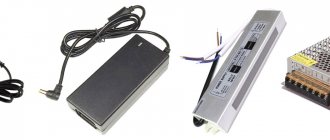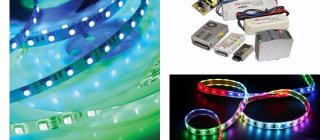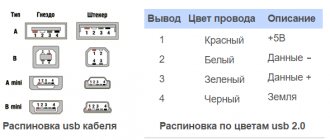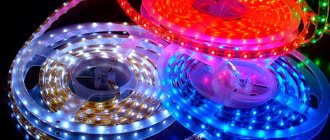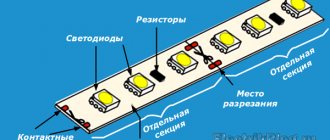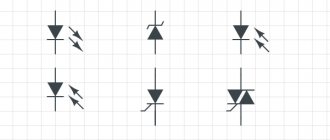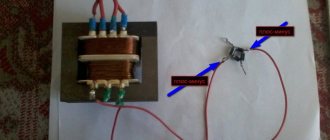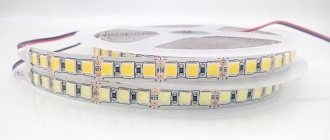Types of switching power supplies
There are many options for the technical design of power supplies.
For weather protection:
- Leaky;
- semi-hermetic;
- sealed.
Unsealed units are intended for use exclusively indoors where there is no high humidity.
By power:
- From 12 W to 800 W;
- current strength from 1 A to 66 A.
By cooling type:
- Passively cooled;
- with active cooling.
Based on body material:
- Aluminum;
- metal;
- plastic.
Calculate what kind of power supply is needed for the SMD LED strip.
When choosing an LED strip, the question arises: which transformer to buy so that the lighting works stably and without overpaying!
We have everything you need to illuminate your cottage, apartment or garden. You can choose everything yourself or contact our sales consultants; Alexey will help you with LED lighting, his phone number is 0. Whatever you buy from us, we will promptly deliver to you using our own delivery service. We also have a service for installing LED strips. By the way, our prices are the lowest in Moscow and the Russian Federation.
In accordance with the specified parameters of the LED strip, you need to select a power supply (transformer).
First of all, we select a transformer based on voltage and power; if these conditions are not taken into account, it can quickly fail or not work at all!
Voltage: we have two options: 12V and 24V, everything is simple here, select the one that matches the tape we have chosen, look at the indicated operating voltage.
Power: if the transformer is not powerful enough, it will heat up and will not last long, it will simply burn out quickly. If the transformer is much more powerful than required, then you will spend more money, since the price increases significantly with increasing transformer power.
The most important criterion when choosing a power supply for an LED strip is power consumption. Below is background information for each type of tape.
LED strips 12V and 24V SMD have the following characteristics:
| Power W | Diodes at 1 meter | LED type |
| 4.8W | 60D | 3528 |
| 7.2W | 30D | 5050 |
| 9.6W | 120D | 3528 |
| 14.4W | 60D | 5050 |
| 19.2W | 240D | 3528 |
| 24W | 204D | 3014 |
| 27W | 90D | 5630 |
| 28.8W | 120D | 5050 |
| 32W | 120D | 5630 |
Therefore, the choice of transformer is very important, calculating which one you need is quite simple: you need to multiply the power of the LED strip by 5 meters or by the meter of the strip you need, if you do not use all five meters, then multiply by your meter.
– That is, 7.2W * 5 meters = 36W + reserve, it turns out you need a 60W transformer, 3.4 Amps of output power..
– That is, 14.4W * 5 meters = 72W + reserve, it turns out you need a transformer of about 100W, a little more than 8 Amps of output power..
It is important to consider the environment in which the transformer will operate; if it is outdoor lighting or a room with high humidity, then be sure to buy a transformer with IP65 protection, waterproof with IP67 immersion. If the room is dry, then you should buy IP20 or IP33, they are much cheaper.
Protection class: choose based on where you are going to use it! If we are lighting where it is damp and humid, then we buy IP65 or IP67, if it is dry and moisture will not get in, then we use IP33.
You can install the power supply for the LED backlight yourself, but you will need to follow important rules and then it will work for a long time, reliably and safely. (We have a service INSTALLATION OF LED STRIPS - you can order it when purchasing an LED strip from us. Installation cost + 10% of the cost of the strip.)
When purchasing, remember that units with a dust and moisture protection rating of IP54 and higher are suitable for wet rooms.
Do not place the unit near a heat source. The temperature of the transformer housing should not exceed 500C.
The unit must have air access of at least 200 mm in all directions (otherwise it will overheat). Therefore, power supplies should not be installed in closed niches.
Do not place it on wood or flammable materials as this may cause a fire.
Do not load more than 80% of the specified capacity. During operation, the housing temperature should not exceed 500C. Otherwise, the maximum permissible load is sharply reduced.
Calculator for selecting a power supply for LED strip
Enter the parameters of the LED strip to be connected and click on the “Calculate” button:
For consultation tel Alexey0
We constantly import new power supplies! We have a large selection at a good price, so transformers do not sit stale. New power supplies have just gone on sale.
We are waiting for your calls, good discounts for wholesale buyers! By clicking on the link you can select a power supply for LED strips
Calculation of the power supply for LED strip
When installing LED lighting, a number of pressing questions usually arise: what is the current consumption of the LED strip, how to calculate the power supply for LEDs, how to calculate the drivers for an unknown strip if the power consumption is not indicated on it? For correct calculation, we use the following table with the nominal parameters of popular matrices.
Table of popular SMD LEDs, characteristics
Calculation of LED strip power parameters
The tape differs in the number of SMD matrices per linear meter. There are options on sale for 30, 60, 120 matrices per linear meter. Depending on the LED matrices used, the rated power of the electricity source for the LED strip will differ.
| SMD matrix type | Number of LEDs per linear meter | Power consumed by 1m/5m tape, W | Required current strength, A at 1m/5m |
| 3528 | 30 | 3,3/16,5 | 0,27/1,35 |
| 60 | 6,6/33 | 0,55/2,7 | |
| 120 | 13,2/66 | 1,1/5,5 | |
| 5050 | 30 | 9/45 | 0,75/3,75 |
| 60 | 18/90 | 1,5/7,5 | |
| 120 | 36/180 | 3/15 | |
| 5630 | 30 | 15/75 | 1,25/6,25 |
| 60 | 30/150 | 2,5/12,5 | |
| 120 | 60/300 | 5/25 |
Which PSU should you choose?
Having visited the first online store you come across for the retail sale of network drivers for LEDs, you can find dozens of various options for transformers for LED strips with a very fair range of costs, which directly depends on the rated power, housing materials, and waterproofing.
The natural desire of every person is to minimize their financial costs. But savings must be expedient and justified. Let's compare several options:
| BP | OEM DC12 12W 1A | OEM DC12 36W 2A | OEM DC12 120W 10A | OEM DC12 360W 30A |
| Appearance | ||||
| Power, W | 12 | 36 | 120 | 360 |
| Current strength, A | 1 | 2 | 10 | 30 |
| Cooling type | Passive | Passive | Passive | Active |
| Housing material | Plastic | Plastic | Metal | Metal |
| Price, USD | 1,8 | 5,2 | 10,5 | 21 |
| Price for 1 W, USD | 0,15 | 0,14 | 0,08 | 0,058 |
As you can see, the stronger the power supply, the cheaper its actual cost per watt. At first glance, purchasing a single sufficiently powerful power supply looks most tempting. Calculation of transformer power for LED strip is done with a margin of about 30%.
Do not forget that absolutely any device has the rather unpleasant property of unexpectedly breaking down at the most inopportune moment. If such force majeure occurs, you will formally be left without coverage. It is most rational, in the case of installing lighting in a room, to power the areas from two to three independent sources.
Calculating the power of the power supply for the LED strip
For the sake of example, let's take a guest room of 18 square meters (3 x 6 meters). The perimeter of the room will be 18 meters. We will need an LED lighting source with a total brightness of 350 lumens/mp (we calculate the brightness based on the recommended lighting levels), for example, let's take smd 3528 60led with a nominal brightness of 360 lm/mp. The total power of this tape for the entire perimeter of the room will be:
6.6 W/m * 18 = 118 W.
From different manufacturers, the brightness of the media may vary significantly; accordingly, the strip in your situation may require a slightly different one; it is advisable to calculate the power of the LED strip according to the passport data from the manufacturer. With a reserve of strength, we will need a device rated at 150 W.
When using several current sources, we divide the entire length of the tape into three sections, taking into account that the standard coil is five meters long. We get two segments of five meters, 33 W and one section of eight meters, 53 W. Power supplies will be required for 40 and 70 W, respectively.
Which is better - one big one or several small ones?
Having completed all the necessary calculations described above. There are several options for the development of the event:
- purchasing one large power supply with the required power;
- installation of several converters, having in total the required power level.
Option for connecting the power supply to the LED strip
It is known that LED strip is sold in reels of five meters. One such coil can be connected to one power supply. In this case, the number of power supplies may vary depending on the total length of the LED strip. Therefore, each extended section of the backlight must be connected to its own converter. This means that to power an LED backlight 15 meters long, the connection circuit must include as many as three power supplies with the power required to power 5 meters of strip (with a margin of at least 20%). Many people do not understand why in such a situation it is impossible to install one powerful power supply unit. It is not recommended to do this, since such an installation scheme will have the following disadvantages:
- the converter itself will have large dimensions. In this regard, it will be very difficult to hide it;
- The large size of the power supply and the power will cause it to become very hot. In such a situation, it is not always possible to create high-quality air ventilation for effective cooling of the converter;
- To cool a large power supply you will need a good fan, and during its operation it will create significant noise. It will be heard especially well at night;
- The fan will have to be cleaned every six months. If you don’t do this, it will simply burn out from overheating;
- a pulse transformer located inside any power supply will produce additional noise, namely an unpleasant squeak. It will not appear immediately, but after some time. The more often overheating occurs, the stronger the squeak of the transformer will be;
- installation of such a converter will be much more problematic and time-consuming.
As you can see, it is much easier to install several power supplies to power a long backlight than to install a large one and then suffer from all the disadvantages of such an installation.
Calculation of LED strip per power supply
As we have already discussed, driver power for LED lighting must be taken with reserve. Therefore, the maximum length of tape allowed for connection is calculated using the formula:
Length (m) = Unit power / (1.3 * Nsmd/m * Psmd)
Ncmd/m – number of smd matrices per linear meter
Pcmd – rated power of one matrix
1,3 – safety correction factor
Calculation of a transformer for LED strip
We calculate the power of the power supply using the same principle:
Unit power = Length (m) * 1.3 * Nsmd/m * Psmd
Procedure and rules for calculating converter power
The main parameter by which a power supply is selected is the rated power. Before calculating the power supply for an LED strip, you need to find out the power of the entire strip and add a margin. The minimum margin value is 30% of the total load.
First of all, you should find out how much 1 meter of product consumes. This data is indicated on the packaging or in the tape passport. If the packaging is lost, the power can be calculated depending on the type of LEDs used. The data is in tables.
Then the length of all pieces of tape that will be connected to the power supply is measured. Power is calculated using the following formula: Pb= Pl*Ll*K, where
- Pb – calculated power of the power supply;
- Pl – power consumed by 1 meter of LED strip;
- Lл – total length of connected pieces of tape;
- K – Safety factor (minimum value 1.3).
A power reserve is necessary to ensure that the unit does not operate at its maximum capacity. If you do not take this indicator into account, the device will not last long - the case and internal components of the circuit will heat up, and the solder points will be destroyed.
Using a computer power supply as a driver
One of the available stabilized 12V voltage sources is a computer power supply. Calculation of a power driver for LEDs based on it has a number of features. The filling of the system unit requires a different voltage - 3.3 V; 5 V; 12 V. Therefore, such a block has several output stages, between which the output voltage is distributed.
The 12V channel accounts for about 50% of the rated load.
The real power of such a power supply = rated power * 0.5/1.3.
Thus, about 60 W will be available to power the LED strip from a 150 W power supply. On the radio market, such “rarities” can be found for 2-3 dollars, which is half the price of standard drivers.
Please rate the article. We tried our best:)
Did you like the article? Tell us about her! You will help us a lot :)
What brands to pay attention to
Nowadays power supplies for LED flexible circuit boards are not produced, perhaps only by lazy people. Therefore, choosing a power supply for an LED strip based on the manufacturer is an extremely thankless job. Nevertheless, focusing on the rest of the products of these companies, we can fairly accurately say how high quality their blocks will be.
Today, Russian Arlight and Taiwanese Mean Well Enterprises Co. have proven themselves well. It makes sense to pay attention to the products of these brands first. In addition, I would like to mention the Chinese Biom, whose products are notable for their low price and good quality. Below we present a selection of six 12-volt power supplies from these companies, the most popular among tape users.
Popularity rating of power supplies for LED strips
| Rating | Photo | Model | Manufacturer | Input voltage, V | Output voltage, V | Output power, W | Output current, A | Degree of environmental protection | price, rub. | Where can I buy |
| 1 | Mean Well LPV-100-12 | Mean Well Enterprises Co. (Taiwan) | 90~264 V AC/127~370 V DC | 12 | 100 | 8.5 | IP67 (sealed) | 1 200 | Ya.Market | |
| 2 | ARPV-LV12060 | Arlight (Russia) | 100~240 V AC | 12 | 60 | 5 | IP67 (sealed) | 2 700 | Ya.Market | |
| 3 | Mean Well LRS-150-12 | Mean Well Enterprises Co. (Taiwan) | 85~264 V AC | 12 | 150 | 12,5 | IP20 | 1 100 | Ya.Market | |
| 4 | Biom Professional BPU-25 2A | Biom (China) | 176~264 V AC | 12 | 25 | 2 | IP20 | 320 | – | |
| 5 | ARS-35-12 | Arlight (Russia) | 100~240 V AC | 12 | 35 | 3 | IP20 | 1 500 | Ya.Market | |
| 6 | JTS-100-12-FA | Arlight (Russia) | 100~240 V AC | 12 | 102 | 8,5 | IP20 | 2 600 | Ya.Market | |
| 7 | Biom TR-60-12 | Biom (China) | 176~264 V AC | 12 | 60 | 5 | IP20 | 250 | – |
Main conclusions
LED strip is actively used in a variety of areas - from street lighting of advertising posters to creating design solutions in the apartment. The lamp is connected to the network through a power supply, which converts the mains voltage to the required 12 or 24 V. Converters differ in power, type of housing, and the presence of additional functions. Before purchasing, it is important to correctly calculate the required power. The load of the block is calculated taking into account the load per 1 meter, the length of the entire tape and the safety factor, which allows you to protect the converter from overheating and damage.
Electrical connection
Manufacturers offer LED strips with various parameters for sale. In most cases, the power supply for LED strips is a network providing a voltage of 220 V. But not all LED devices are designed to be connected to a regular outlet. The tapes that are in greatest demand among consumers require a power source with voltage parameters of 12 V or 24 V. If they are connected directly to an outlet, they will not work and may burn out. These devices are designed for a completely different level and type of voltage, and such an LED device must be connected via a transformer. For LED lighting, developers present special transformers for LED strips that provide a stable output voltage.
Interesting material for review: useful information about current transformers.
Connecting the transformer to the power supply.
Reasons for LED strip failure
The most common cause of strip failure is an attempt to power the LED strip not through an adapter for an LED strip, but to use a driver for this. Many people confuse these devices and thereby create unacceptable conditions for SL operation. The difference between a driver and a power supply is that it stabilizes not the voltage, but the current at the same level.
Each LED, despite its external similarity and specified parameters, is a unique device in terms of current consumption. In an LED strip, one LED can consume a current of 2.0 A, another 2.7 A, and a third 1.7 A at the same voltage.
This unevenness causes the LEDs to operate unstably. Some shine brighter, others dimmer; as a result of such inconsistency, LEDs that consume more current quickly overheat and fail.
You should never replace a SL power supply with a driver.
Kinds
Power supplies for LED strips powered by 12 volts do not have a single classification, but all of them can be conditionally divided based on technical, design and functional features. Let's consider this point in more detail.
Execution option
An unsealed power supply is an open type design, usually in a perforated steel case.
In this design, all elements of the printed circuit board are perfectly cooled naturally. An open power supply unit for an LED strip has the largest dimensions and therefore requires a lot of space for installation. However, this drawback does not affect operation and is a consequence of the use of inexpensive, larger-sized radio components with low packing density. The good thing about non-sealed power supplies with 12V output is that they can be selected in a wide range of output powers from 6 to 400W. The semi-sealed power supply (PS) for the LED strip is protected from small foreign objects and is manufactured in a plastic or plastic housing. With equal power ratios, a semi-hermetic power supply has smaller dimensions than its open counterpart. The minimum power threshold supplied to the load is approximately 60 W, since it is not economically feasible to produce low-power devices. The network adapter is a type of semi-sealed power supply that differs in form factor. In appearance it is very similar to a mobile phone charger. The downside is that the compact size of the case limits the load capacity for connecting the LED strip to 2 A (24 W). A sealed power supply has several positive aspects. The case is made of high-quality material that protects the filling of the device from any influence of the external environment.
Its dimensions are comparable to the semi-hermetic version. 12 V voltage sources with a load output of no more than 36 W can be produced in a sealed plastic case. The cases of more powerful models are made of aluminum alloys. The aluminum case additionally serves as a radiator for the power elements of the power supply circuit.
Degree of protection against moisture and dust
Any commercially produced enclosure for electrical equipment is tested for possible penetration of solid objects and moisture into the body according to approved international standards. As a result, the device is assigned a certain degree of protection (abbreviated IPxx, where xx is a two-digit number), which determines the possible acceptable conditions for its operation.
The level of protection according to the IP standard is a mandatory characteristic of power supplies for LED strips, since this parameter indicates acceptable operating conditions and is one of the key ones when choosing a product. Let's consider the three most common degrees of protection of power supplies for LED strips with a supply voltage of 12 volts:
- IP 20, power supply with an open housing type. The circuit elements are protected by a metal casing with holes with a diameter of at least 12.5 mm. The electrical circuit is well protected from touches from fingers and large objects; there is no protection from water or small objects.
- IP 54 power supply for 12 V LED strip with partial sealing. It has complete protection against contact with objects and partially with dust. Splashes of water from any direction are not able to penetrate inside the device.
- IP67 or IP68. Products in a sealed housing with complete protection from dust. In the first option, short-term immersion in water is allowed, in the second, the device can operate under water for a long time. Typically used for illumination using LED strips on the street.
When choosing a power source, you need to remember: the higher the IP protection, the more expensive the product. If there is no need for protection from moisture and dust, it is recommended to choose a power supply with IP20.
Features of power supply circuitry
According to the principle of operation, all power supplies are divided into 3 types: linear, pulsed and transformerless (one version of their circuits is presented below). Linear-type power supplies, as an invention of the last century, were actively used before the advent of switching power supplies. Their circuit is extremely simple: a step-down transformer, a rectifier, a filter and an integrated stabilizer.
Manufactured with a decent margin of safety, they can withstand overloads and operate at idle for a long time. But a bulky and expensive transformer of large mass in tandem with low efficiency prompted scientists to create switching power supplies.
The switching power supply for a 12 V light-emitting LED strip is a little more complex in circuit design, but is distinguished by its high efficiency, low weight and compact size.
The only serious drawback is the prohibition on turning on without load. In this mode, there is a high probability of failure of the power transistor. But this problem has already been solved by introducing feedback. As a result, at idle, the output voltage does not exceed the permissible value.
Transformerless units are practically not used to power LED strips. In them, the 220 V mains voltage is reduced using an RC circuit with further stabilization.
Despite the fact that this is the cheapest way to obtain the voltage at the desired level, it is also the most dangerous. Transformerless sources do not have galvanic isolation from the network. This indicates the invisible presence of high potential on all elements of the electrical circuit. For this reason, they are not sold separately, but are an integral part of electronic devices, such as cheap LED lamps.
For a 12-volt LED strip, it is recommended to use a switching power supply.
Additional functions
Today on the market you can find power supplies with a wide variety of additional functions: from a simple voltage indicator on an LED to remote voltage control. In some cases, add-ons can be very useful, in others they can be completely useless. Before choosing a product, it is recommended to clearly define the requirements and functions of the product.
Overview of types and principle of operation
Such devices operate according to a similar scheme: the 220V mains voltage is converted to a lower voltage - 12V. This feature is realized by means of a transformer, which reduces the voltage to the level of 12V. This is the simplest power supply that allows you to connect low-power lighting devices. To install more powerful lamps, power elements designed for 24V, 36V, 48V are used. In addition to the step-down transformer, the design of the unit includes a rectifier, stabilizer and filters (RC or LC).
There are two types of such devices, which differ in the cooling method:
- with passive heat transfer;
- with active cooling system.
In the first case, the power supply can be made in a closed or perforated case, and the heating intensity of the case is reduced through natural cooling.
Interesting reading: facts about step-down transformers.
The second option includes a fan in the design. Such a unit has very significant disadvantages: the need to regularly clean the device, since the fan pumps in quite a lot of dust, and, in addition, during operation, an obsessive noise is heard, which does not always suit the owner of the room. There are different versions of the power supply unit for the LED strip, different in size. If you plan to install decorative low-power lighting, you can use a compact version.
In addition, the market offers models of devices that differ in the material from which the body is made: plastic, aluminum. The main difference is the set of functions:
- providing power to the light source;
- devices with built-in dimmer;
- possibility of remote control;
- Full-featured devices: with dimmer and remote control function.
The power range of such equipment can vary from 4 to 2,000W. If you plan to install the lighting in a room with a high level of humidity, use a special type of power supply - a moisture-proof one.
